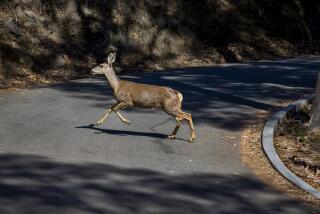The Deer Hunt Goes Suburban
CINCINNATI — Under cover of morning darkness, the Merrie Men of Downtown rumbled through the city, loaded for deer.
A pickup and a van passed the baseball stadium and the high-rise business district to converge, as planned, on Weebetook Lane. The drivers parked on a block of stately dwellings. They drew camouflage outfits over their jeans and reached for their crossbows and quivers.
They waved to a passing dog-walker.
Then the Merrie Men, as they style themselves, strode into the backyard of a brown stucco house. Mike Reed, a butcher by trade, climbed into a sycamore. Brewer Rick DeBar shinnied up a spruce. They would crouch there all morning, until Reed bagged a doe.
Similar scenes are being repeated across the country in cities and suburbs where deer populations have grown so rapidly that frustrated residents are turning to weapons in an effort to thin the herds. The movement is strongest in the Upper Midwest and Northeast, where deer are most plentiful. Arrows and bullets may have no place in their neighborhoods, they reason, but neither does the white-tailed deer.
Increasingly, laws against firing projectiles are being waived for citizen archers and police sharpshooters: in Cedar Rapids, Iowa; Kansas City, Mo.; near Pittsburgh, Boston and Milwaukee. In Minneapolis and St. Paul, authorities keep a registry of 1,000 bowhunters ready to serve when local governments call.
The urban hunt, deer researchers say, is the most cost-effective solution to a situation that people brought on themselves, having built sprawl far into the forests and demanded landscaping in their towns. At the beginning of the century, 1 million deer roamed the United States. As the number of natural predators--such as wolves--dwindled in the face of construction, the deer seized whatever cover they could find. The results were spectacular: Their population is now about 18 million.
When deer appear in a developed community, “at first, people are really pleased to see them,” said Marty Jones, urban deer project manager for the Illinois Department of Natural Resources. “Then more and more come along. Then they cease to be cute.”
After all, the creatures munch floral arrangements left on veterans’ graves at Jefferson Barracks National Cemetery in St. Louis. The sheer volume of their droppings interferes with child’s play in Bloomington, Minn. They shred golf courses, scrape tree bark and upend garden plants.
Most disturbingly, on boulevards and freeways they collide with cars driven by astonished commuters. The accidents, which nearly always kill the deer, also cause an estimated 29,000 human injuries and 200 human deaths each year--not to mention requiring $1 billion in auto repairs.
Still, metropolitan hunting is far from acceptable to all. In Southern California, for example, state wildlife managers say they’re rejected whenever they broach the notion to officials in Los Angeles, Riverside or San Bernardino counties. Although complaints about too many deer are common enough, politicians’ aides “would not even set up the meetings,” said Larry Sitton, the region’s lead senior biologist for the state Department of Fish and Game. “The climate has been one of concern for political correctness.”
Getty Center Hires Shoo Crew
The private Getty Center also refused to consider killing the herd that’s been feasting on vegetation at the museum’s new site in Brentwood. Instead, Sitton said, the Getty hired people to wave their hands and shoo the deer away.
Humane societies and animal-rights groups have lobbied against hunts, urging other methods of ridding towns of deer. And the divided nature of the public is illustrated by four recent deer-hunt referendums in the Cleveland-Akron area of Ohio: The measures passed in Aurora and Moreland Hills. They failed in Walton Hills and Strongsville.
Even some sportsmen are critics. This type of hunt, after all, is a far cry from the forest camp-outs more commonly associated with stalking and killing wild game.
In Cincinnati this month, the closest Reed and DeBar got to being at one with nature was enduring light rains that drizzled down twice.
Wind chimes tinkled nearby. A police siren wailed. A car backed out of a driveway across the street, its headlights visible through a low predawn mist. The scent of evergreens was augmented by the odor of frying bacon from a kitchen up the hill. The breeze bore a trace of Teaberry gum.
“It doesn’t get any more urban than this,” DeBar said.
Yet the ghostly outlines of two deer had been waiting when the hunters arrived. “Look! Do you see them?” Reed whispered. The animals scampered away.
The hunters were called into the neighborhood in the fall of 1996 by Susan Laffoon, who works at the Greater Cincinnati Chamber of Commerce.
For nine years, she has lived in the brown stucco house on Weebetook Lane. Three years ago, she glanced out a window to her front lawn, which is enclosed by a high brick wall. “Those are the biggest dogs I ever saw!” she exclaimed. A second look revealed that the “dogs” were deer.
Soon, everyone on the block was complaining about the sad state of the gardens. “You put hundreds of dollars into tulips and roses, and the deer just keep eating them up,” Laffoon said.
When she read a mention in a local newspaper of the Merrie Men--who’d been hunting near the airport as jets whined overhead--Laffoon begged for help. Four other families also granted written permission to harvest the land where the back lots run together, sloping into a creek-lined ravine. About 30 acres were available, all told.
Reed and DeBar took one look at the damaged trees and knew they’d been offered one sweet spot.
By last Christmas, the Merrie Men had taken nine Weebetook deer, despite attracting competition from the brother-in-law of one neighbor’s cleaning lady.
Reed, who works at La Maisonnette, a well-regarded French restaurant, cooked the Laffoons a thank-you dinner for 10. On the menu: pumpkin soup with truffles, a puree of chestnuts and, of course, venison grilled in the yard whence it came.
Ohio Encourages Bowhunting of Deer
Almost two weeks ago, he presented Laffoon with yet another token of his gratitude: home-grown antlers mounted on a plaque. “I’m going to hang this in my office,” she said. Smiling, she contemplated a new tourism slogan--Hunt Cincinnati!
The Merrie Men’s loosing of arrows is not only legal but encouraged by the state. Ohio’s Division of Wildlife established five urban deer zones in 1994. Guns are not allowed for safety reasons, but anyone in Cincinnati, Cleveland, Columbus, Toledo or Youngstown is entitled to buy bowhunting permits to kill three deer--two more than allowed in the outlands, and urban permits cost half as much.
“You want to find a trophy buck, go to the urban zones,” cajoled Michael Tonkovich, the state’s deer project leader. “The deer there have been protected; they get a chance to mature.” Such talk is pure marketing; the state is actually most anxious to kill fertile does.
The countryside is still far more hunted, with about 300,000 permits purchased annually. But slowly, more and more city folk are taking Tonkovich up on his offer. In 1994, Ohio sold almost 4,000 urban tags. In 1996--the most recent year for which figures are available--that number grew to more than 21,000.
Reed, 34, jumped at the chance to kill deer close to home. He’d been making those three-hour drives to eastern Ohio, setting up camp for two days, hunting two more, then heading back to Cincinnati and his none-too-pleased wife. With urban tags, he could hunt and do his household chores all in the same day.
As a partner, he recruited DeBar, 27, who hunted as a kid in Pennsylvania. Every Saturday in season finds them on the trail. Two others from the Cincinnati food scene sometimes join in. They too are Merrie Men of Downtown, said DeBar, “because that’s where we work and that’s where we hunt.”
After they take from the rich, they usually give to the poor. Last season, they donated 700 pounds of meat to shelters and soup kitchens serving the homeless. “Oh, they all liked it,” said Earl Hunt, cook at the Drop Inn Center. “They didn’t know what they was eating.”
The Merrie Men worry about controversy, mindful that an eastern suburb allowed hunting one year and rescinded permission the next.
Town officials there were subject to the same pressures surfacing in New Jersey as county parks were opened to hunts. The New Jersey Animal Rights Alliance has spoken out at township meetings and handed out fliers condemning the killing of deer.
“Neighborhood kids may come trampling through your vegetables and rose garden, but we don’t go out and do wholesale slaughter of them,” said Janine Motta, an alliance board member. Explore other solutions, she urged.
There aren’t many. Slow speed limits can be enforced and drivers can be educated that deer are on the move during spring foaling and fall breeding seasons, suggested Robert J. Warren, a wildlife ecology professor at the University of Georgia.
Deer also find some plants less delicious than others. But nothing is totally immune if hunger strikes.
Trapping deer can cause pain for the animal. Besides, there’s no place to move them; no one wants them. And they’ve been known to travel up to 30 miles to return to their own comfortable grounds.
Contraceptive injections are in the experimental stage. They are expensive, and each doe must be captured twice because booster shots are necessary. The technique can take up to 10 years to reduce a herd.
Police Work Overtime Picking Off Deer
Researchers are even working to induce abortions in deer through a vaccine administered at bait stations after the fall rut ends. But it’s not ready yet for wide-scale use.
“Right now, only two things work,” said Jay McAninch, deer research biologist for the Minnesota Department of Natural Resources. “Sharpshooting and some form of hunting.”
To assuage worries about safety, some local governments pay police snipers overtime to pick off deer, running the cost of the kill up to $400 per animal. Others opt for bowhunting, theorizing that silent arrows are less threatening than shotguns reporting through the neighborhood. The price slips under $200 a deer, and if archers must pay fees, a town can actually turn a profit.
In Minneapolis and St. Paul, bowhunters on the registry must sign an ethics pledge and pass a proficiency test as well.
Through the autumn, Reed counted 30 different deer in the Laffoons’ backyard. One was a yearling he named Wilma. Her little brother he dubbed Willy. And a buck with antlers spreading more than 20 inches wide he christened Wally.
“He fits his name,” Reed said, grinning through his stubble, “ ‘cause when I get him, he goes right on the wall.”
But it was Wilma who ran into his sights, just 15 yards away. Reed pulled back, released and twanged his arrow into her right rear haunch, severing her femoral artery. She toppled instantly.
Wally moved into view. “I’m sorry,” Reed mouthed to DeBar in the other tree. By firing, he’d ruined his companion’s chances for the buck.
The big deer ran to Wilma for a quick inspection, then galloped across a fallen tree, up a hill and across a front yard, out of range.
Reed picked his way over and unsheathed a 3-inch knife. Blood steamed out as he gutted his 100-pound kill. He pocketed the heart. “I’ll pickle it,” he said. “Makes a great appetizer.”
He grabbed Wilma’s forelegs and DeBar took hold of her hind legs. Together, they carried her past the Laffoons’ porch and the barbecue, along the flagstone path toward the driveway.
No way they were going to lash their doe outside the van, as country hunters do. Instead, they discreetly placed Wilma atop a tarp in the back.
They would register her with the state. But first, they decided, a late breakfast was in order. On a boutique-lined street, they left Reed’s van--and Wilma’s corpse--in a metered parking spot.
As they entered a coffee shop, DeBar reminded Reed to wash off his blood-speckled face and hands. “Who knows what people will think?” he asked. No one, he knew, would believe they’d just brought down a Cincinnati deer.
More to Read
Sign up for Essential California
The most important California stories and recommendations in your inbox every morning.
You may occasionally receive promotional content from the Los Angeles Times.










